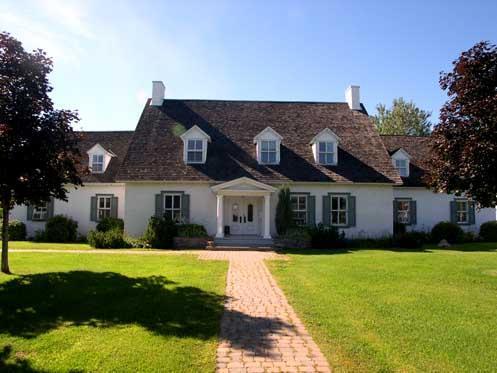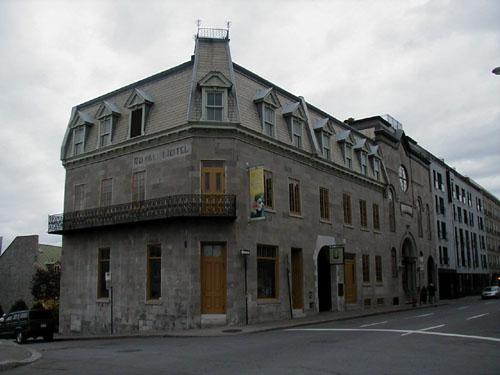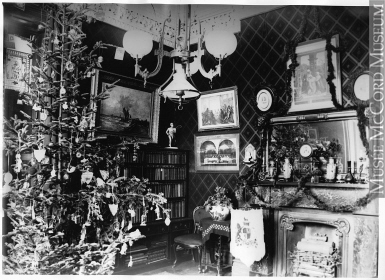Deck the Halls! Historic Places and the Holidays
As you prepare for Christmas, would you say "bah humbug!" if
interrupted by the "Ghost of Christmas Past?" Don't be a mean
Ebenezer Scrooge. The ghostly spirit has much to show
you. 
Let the "Ghost of Christmas Past" take you back to Christmas,
1781 at the Governors' Cottage in Sorel, Québec. Located
about halfway between Montréal and Québec at the confluence of the
Richelieu and St. Lawrence Rivers, this great mansion stands alone
in a rural landscape. You may feel the tensions of a land
that is ruled by the British and farmed by the French, as well as
the unsolved problem of the American War of Independence which is
still raging to the south. For the new German residents of
this home, General Friedrich Adolph von Riedsel and his wife
Friederike Charlotte Louise von Massow, the feeling of isolation
could never be greater. Step into this picturesque
one-and-a-half-storey house, built in the "tradition québécoise",
and you'll be comforted by the glow from white candles on the large
pine tree. You'll be the first in North America to see this
spectacle, as Charlotte - perhaps to overcome her isolation - has
brought old-world Christmas traditions to her new home. It
will take a few decades - not until the 1840s in fact - before this
Christmas tree tradition is embraced elsewhere in Canada.
Now follow the Ghost of Christmas Past into the future, to 1861.
This Christmas, Canada is not yet a country, while south of the
border, the American Civil War is raging. Both English and
French communities in the Canadas enthusiastically celebrate
Christmas. Come visit Montréal's impressive Sir George Etienne Cartier House. Cartier is a
strong proponent of the idea of Canadian Confederation.
The swish of women's long, stiff hoop skirts is heard as hired
staff prepare a sumptuous dinner. Cartier House has new decorations
- sold by Montréal merchants starting in 1860 - of mistletoe balls
and holly leaves hanging from elaborately wallpapered walls,
decorative mouldings and dark wood banisters. Colourful
Christmas cards - also a new tradition - adorn the huge
mantelpiece. A Christmas tree, decked with glass balls (or kugels),
candles and garlands, dominates a corner parlour. Basking in
the warm glow of oil lamps, the richly furnished rooms take on a
special Christmas magic.
In the French-Canadian tradition, Christmas celebrations start
with Midnight Mass, followed by a "Réveillon" meal: dinner is at
midnight on Christmas Day. There are tantalizing smells coming from
tourtière (spiced meat pie), roast goose, apple sauce, mashed
potatoes, sweet and savoury pudding (made of beef, raisins and
prunes), mince pies and Yule logs. Malt beer and other
spirits have been shipped from Toronto's newly established Gooderham and Worts Distillery. In the
early 1860s, the tradition of gift-giving is becoming common
practice. For children, boys might find a lead soldier
sticking out of a Christmas stocking while girls might receive a
German-made doll with glass eyes.
At the end of the day, you may be overwhelmed by the number of
guests the Cartiers have invited: up to 50 people will have arrived
by horse-drawn carriage or sleigh to join in parlour games,
dancing, and carol singing. As snow begins to fall on the
streets of Montréal, listen for the Cartiers singing traditional
French "chants de Noël", or newer songs such as "Cantique de Noël,"
"O Holy Night," "Hark the Herald Angels Sing," and "Jingle
Bells." Some of the Cartiers English friends are reading
aloud Clement Moore's The Night Before Christmas, popular
since the 1820s, followed by passages from the much-loved Charles
Dickens' classic from the 1840s, A Christmas Carol.
Now follow the Ghost of Christmas Past to 1921. Canada is
a growing and  prosperous nation following the end of
the First World War. In some places, older Christmas
traditions are still followed. The ghost might spirit you
away to such diverse places as the Brooksdale School in rural Saskatchewan, the
focal point for the tiny community's Christmas concert; or to the
Molstad House in Edmonton, Alberta, where Mrs.
Addie Molstad is hosting the Bonnie Doon neighbourhood children's
Christmas party; or to Reverend Charles Gordon's house in Winnipeg, where an array of guests -
including authors, publishers and politicians - arrive in Model-T
Fords to hear a Christmas sermon before sitting down to a dinner of
turkey and cranberry sauce.
prosperous nation following the end of
the First World War. In some places, older Christmas
traditions are still followed. The ghost might spirit you
away to such diverse places as the Brooksdale School in rural Saskatchewan, the
focal point for the tiny community's Christmas concert; or to the
Molstad House in Edmonton, Alberta, where Mrs.
Addie Molstad is hosting the Bonnie Doon neighbourhood children's
Christmas party; or to Reverend Charles Gordon's house in Winnipeg, where an array of guests -
including authors, publishers and politicians - arrive in Model-T
Fords to hear a Christmas sermon before sitting down to a dinner of
turkey and cranberry sauce.
In other places, new traditions are being established.
Children now expect Santa Claus to come down the chimney, bringing
toy trains, airplanes, dolls, books, sailor suits and
dresses. Wrapped gifts from Eaton's department store are now
placed under Christmas trees lit with electric lights. The
ghost may take you to see the Saint Vincent de Paul Society Building in Saint
John, New Brunswick, where members of the society are aiding the
poor, handing out used clothing and providing dinners to needy
families. In the urban metropolis of Toronto, the ghost
brings you to Parkdale's Pavlova Dancing Academy, where men sporting new
trilby hats and women showing off the new "flapper" look of short
pleated skirts, cloche hats, and bobbed hair are arriving by the
Queen West streetcar to attend a Christmas dance. At this
dance, a jazz band plays the 1921 hit "Ain't We Got Fun," a new
Christmas song called "Carol of the Bells," and other tunes.
 The ghost also takes you to Ottawa's Laurier House, the new home of William Lyon
Mackenzie King. Though King will not officially move in until 1923,
he is enjoying this inheritance - a bequest from Wilfrid Laurier's
wife, who died in 1921 - and his recent election victory. In
his diary, he writes: "Spent the day quietly opening gifts and
telegrams and cards and reading letters...I have loads and loads of
letters and cards, cannot possibly overtake them even to open and
read...How true is the saying that a man's happiness is noted in
the abundance of his riches...Went to church tonight, listened to
the Elijah and after had supper with Col. and Mrs. Thompson...to
bed and not to sleep till after 2." King may also be wondering how
to find time to renovate Laurier House while governing Canada with
a minority government when he officially becomes Prime Minister on
December 29th, 1921.
The ghost also takes you to Ottawa's Laurier House, the new home of William Lyon
Mackenzie King. Though King will not officially move in until 1923,
he is enjoying this inheritance - a bequest from Wilfrid Laurier's
wife, who died in 1921 - and his recent election victory. In
his diary, he writes: "Spent the day quietly opening gifts and
telegrams and cards and reading letters...I have loads and loads of
letters and cards, cannot possibly overtake them even to open and
read...How true is the saying that a man's happiness is noted in
the abundance of his riches...Went to church tonight, listened to
the Elijah and after had supper with Col. and Mrs. Thompson...to
bed and not to sleep till after 2." King may also be wondering how
to find time to renovate Laurier House while governing Canada with
a minority government when he officially becomes Prime Minister on
December 29th, 1921.
When at last the "Ghost of Christmas Past" gently returns you to
the present, you may ask of it: "What do these past Christmases
have to do with the present?" The ghost answers: "Love with holiday
spirit the history that makes us who we are and Canada what it is,
for these scenes from our past all belong to our Canadian
inheritance. Learn about it! Re-experience it! Share it! All
these historic places and the stories they share are the Canadian
Register's gift to you this season. Happy Christmas to one and
all!"